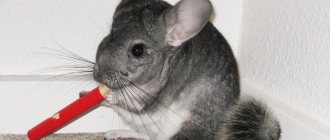- home
- Rat
- Good to know
05/29/2019 The desire to have a companion animal at home arises for various reasons.
Some simply love all living things, others are escaping loneliness, and still others are looking for a playmate for their child. Some people are frightened by the sight of a decorative rat and even disgusted. These animals don't deserve this kind of treatment. After all, good looks do not always mean a pleasant disposition.
Most likely, a negative reaction to tame rodents arises from comparing them with wild relatives. The rat, as a pet, has lived next to humans since the 18th century and is very different from its ancestors. This is a cute and smart creature.
The main advantages of keeping a rat
Fortunately, the advantages of decorative rats are much greater than the disadvantages. Below are listed only the main positive qualities of the animals.
High socialization
Rats do not tolerate loneliness very well; they prefer to live in small same-sex groups. At the same time, animals show care for their relatives:
- brush each other's fur coats;
- feed weakened individuals;
- show sympathy;
- warn of impending danger.
Fights and conflicts between rats are a very rare phenomenon, which is observed mainly in males during sexual activity.
High cognitive abilities
Contrary to popular belief, rats are very smart. Their intellectual abilities are on par with cats and dogs. Rodents remember their name well and are easy to train.
Fluffies can be taught on their own such commands as “give me a paw”, “lie down”, “come to me”. Rats also perform simple tricks - walk on their hind legs, roll a ball, spin around their own axis, jump from place to place.
Easy to care for
The cute fluffies are quite easy to care for. Difficulties may arise at first, but the main thing is to get used to it. By choosing a cage with a removable tray, cleaning takes literally 10-15 minutes.
Sawdust or shredded toilet paper are used as filler. You can feed your rodent either specialized food or natural food. The only caveat is that you need to remember the list of prohibited products.
Doesn't take up much space
Decorative rats are quite compact. Their body length is about 20 cm. Therefore, several individuals can be kept in one multi-tiered cage at once - up to 5-6 pieces. The rat house itself does not take up much space. The cage will easily fit on a desk or bedside table.
Affordable price
The price of a decorative rat, even one raised in the most prestigious nursery, is unlikely to rise above 2,000 rubles. And at the poultry market or by hand you can buy a purebred pet for only 500-700 rubles.
It is better to buy rats from professional nurseries. Because pups raised by experienced breeders are more socialized and healthier.
Easy to transport
Rats tolerate moving well even over long distances. All that is required for comfortable transportation is a special carrier with a secure lock, while ensuring air circulation. The small weight of the animal - within 500 grams - will prevent the owner from getting tired during the trip.
Big choice
There are many breeds of decorative rats, so everyone will find a pet to their liking. Among the varieties there are different animals: compact and bulky, bald and fluffy, with straight and curly hair, with large and small ears, albino and fluffy with complex colors.
Cleanliness
Many people believe that the destiny of rats is to climb through garbage dumps and rummage through garbage. However, ornamental animals are very different from pasyuki. Cute fluffies are very clean.
They perform daily activities to maintain the cleanliness of their body: they wash themselves after each meal and lick their fur. And if several individuals live in a cage, they happily clean each other’s fur coats. In addition, decorative rats love to swim. The owner must take care of organizing water procedures.
Attachment to the owner
Rats quickly get used to their new owner and happily spend time with him. In addition, cute animals gradually get used to the rest of the family members. If a rodent feels good about itself, it will never bite, scratch or run away from home.
Possibility of litter training
Rats are very smart, so they can be trained to go to the toilet in one designated place. This will only require a few trays (according to the number of pets in the cage) and a little patience.
The duration of toilet training is from 2 to 4 weeks. If the rat gets used to the litter box, the process of cleaning the cage will take much less time.
Activity
Decorative rats are very active - they really like to play with their relatives, exercise on apparatus in the cage, and explore everything new. It is very interesting to observe the life of fluffies from the outside. If you have free time, you can spend hours on end watching cute animals frolic.
Since rats are very active, it is better to purchase multi-tiered cages for playful animals. 2-3 floors will be enough for males, 4-5 tiers for females.
No need to spend a lot of time together
Rats love their owners very much and are always willing to play with them. But if the furry owner doesn’t have much time to spend together, it’s okay. Fluffies are able to keep themselves busy - they exercise on apparatus, play, and frolic with their cage neighbors. At the same time, the rodent does not develop any resentment towards humans.
No need to go outside
Other pets, such as cats and dogs, need a lot of space. In addition, such large pets prefer to go to the toilet outside.
With rats everything is much simpler. The little animal feels quite comfortable in a cage. And to release the accumulated energy, a play complex installed in a cage is enough for a rodent.
Interesting to watch several pets
The pair of pets is fun to watch - the rats often jump and “fight” with each other. Children especially like rat antics, who can build them different climbing frames and create toys. Rats are curious and enjoy exploring new places and objects. You can teach a rat to come running when a certain sound is heard and do other interesting things thanks to educational videos on YouTube.
Cons of content
Unfortunately, rats do not have their drawbacks. But the shortcomings of these cute rodents are very minor, and they can be easily dealt with.
Tendency to diseases
Rats have a fairly weak immune system, so fluffies often get sick. In addition, a predisposition to certain diseases is inherent in them at the genetic level. Most often, rodent owners encounter the following ailments of their pets:
- ARVI;
- malignant and benign neoplasms;
- mycoplasmosis;
- atherosclerosis;
- renal failure;
- pneumonia.
Rats also often suffer from fleas, lice, ticks, worms and other parasites.
Short lifespan
On average, rats live about 3 years. Compared to other types of pets, this is a very short period of time. Some varieties of decorative rats, for example, albinos, live only 1.5-2 years. Long-livers are also found among rodents. With proper care and timely treatment, a rat can live up to 4-4.5 years.
Marking territory
Some novice breeders mistakenly believe that only males mark territory. However, females also put their marks everywhere. The only difference is that the urine of male rats has a more pungent, specific odor. Regular cleaning of the cage will help solve this problem.
Unpleasant smell
During the life of a rat, like any other animal, an unpleasant odor is released. And it doesn't just come from excrement or urine. The endocrine glands also emit a specific aroma, to get rid of which you will have to regularly subject your pet to water procedures.
Unpleasant associations
The appearance of rodents, to put it mildly, scares some people away. Some consider cute decorative fluffies to be as aggressive as their wild relatives. And some breeds, for example, the Sphynx, are generally terrifying to especially impressionable people.
Damage to things
As long as the rat is in the cage, its owner’s property is completely safe. But rodents are very agile and are able to open a weak lock on their own. If he escapes, the fluffy will chew everything that gets in his way - furniture, wallpaper, clothes, wires. Therefore, it is recommended to place even a cage with a rat away from walls and any things - otherwise the rat can reach them through the twigs.
Noise at night
Rats are nocturnal animals. Therefore, they often go to bed only in the morning. And at night they stay awake, play, frolic, learn everything new. This feature can cause discomfort to owners, especially if small children live in the house. To ensure that pets do not disturb anyone’s sleep, it is better to place the cage in a separate room.
Aesthetic problems
Adult male rats have very prominent genitals. This is especially noticeable in representatives of short-haired and hairless varieties. This feature is very off-putting or confusing for some people.
Expensive treatment
The health of rats is quite poor; fluffies get sick very often. Therefore, they will have to be treated constantly, paying considerable sums for medical services. Moreover, ordinary veterinarians rarely work with such small animals as rodents. Most likely, you will need to look for a special doctor for rats - a ratologist.
The problem is aggravated by the fact that there is only one specialist for 2-3 cities. Therefore, for treatment, you may have to transport the animal to a neighboring village.
Nutrition and care
To live, a rodent needs a spacious cage . You can buy it at any pet store. There are models with additions (wheel, ladders, house, etc.). They are better suited for a young animal, it is more active. An adult rat does not need regular exercise. Boxes, cans or containers must not be used. Once a week, the cage must be thoroughly washed and disinfected to avoid diseases and germs.
Large sawdust will be the best filler. Small particles can get into the animal's eyes and respiratory tract. If you choose paper, it should be clean, without writing or ink.
The diet includes fruits and dried fruits, grain feed, vegetables, dandelion leaves, chicken bones. It is not recommended to give meat often, maximum once a week. You should not give your rat salty, smoked, fried, sweet, sausage, bread, cabbage, potatoes, radishes, beets, soy milk and cheese, almonds. It is enough to feed adults 2 times a day , cubs - 3-4 times in small portions.
It is advisable to place a mineral stone in the cage so that the pet receives the necessary dose of calcium. The water in the drinking bowl needs to be changed daily.
Is it worth getting a decorative rat?
Whether it is worth having a decorative rat as a pet is a rather controversial issue. On the one hand, little fluffies have many advantages. And the most important of them is boundless love and affection for the owner. The animal loves to spend time with people, loves to be petted, and enjoys being held. Therefore, rat owners are never bored or lonely.
On the other hand, rats are not without certain disadvantages. Therefore, if you have the desire and ability to cope with difficulties, it is still worth getting a pet. Rats are very smart and sociable, so they are in no way inferior to animals such as cats and dogs.
Note to future owners
In order not to make serious mistakes, you need to know some of the nuances of keeping decorative rats:
- Do not leave the cage with the rodent in a draft or in direct sunlight. The animal will not survive even a few hours in the sun.
- It is advisable to keep an inquisitive animal in a cage. While walking, do not let him out of your sight. Otherwise, while exploring the territory, the rat will damage things and furniture or eat something inappropriate for it.
- The rat chews on everything. Buy a cage designed specifically for rodents. To make it easier to wash, it should be of simple design and light.
- Doors - the wider the better. This makes it easier to get the animal if it resists.
- Don't place your pet's home near the wall; she will chew the wallpaper.
- Keep your pet's cage clean: remove stagnant food, provide fresh water daily, replace bedding and litter. This will help avoid unpleasant odors and the development of infections.
- The rat is trainable; teach it to use the toilet.
- It is noticeable from the animal’s behavior that it is boring for it to live alone. They do almost nothing except eat and rest. Immediately buy her a mate of the same sex. The animals will have more fun together.
In what cases should you refuse to purchase a rat?
Despite all the positive qualities of decorative rats, in some cases it is still better to refuse to purchase rodents as a pet:
- The family has small children. Rats get along great with kids. But, unfortunately, animals very rarely live longer than 3 years. Therefore, the child will inevitably experience the pain of loss. It is quite difficult for children, especially preschool age, to explain what happened to the pet and where it went. Moreover, situations cannot be ruled out when the furry dies right in front of the child. Particularly impressionable children can receive real psychological trauma.
- Lack of free time. Despite the fact that rats are capable of keeping themselves occupied, they will still need to be given a certain amount of attention every day. In addition to communicating with your pet, you will need to find some time for feeding, cleaning the cage, treating, and bathing the animal. People who often go on business trips should especially give up the idea of getting a rat. Even if you ask a neighbor or friend to care for your pet, the animal will be constantly under stress due to the change of owners.
- At least one family member has allergies. Like any animal covered with fur, a rat can cause severe allergic reactions in the form of skin itching, hives, and swelling. In rare cases, a life-threatening condition such as anaphylactic shock may occur. The only exception is the hairless sphinx rat - it is completely hairless, so it does not cause allergies.
- Presence of cats or dogs in the house. Rats are quite friendly towards other pets. But if the hunting instinct awakens in a larger animal, the rodent will, at best, receive serious injuries. And in the worst case, he will be eaten. If you decide to get a rat, you will need to protect it from potential danger.
Having carefully studied the advantages and disadvantages of a domestic rat, everyone will understand whether it is worth having an animal as a pet. When making a choice, you need to carefully weigh the pros and cons, since an animal is not a toy, but a real family member with whom you will have to spend a lot of time.
Is it true that they are marking territory?
Many people say that they leave drops of urine everywhere. This behavior is quite normal; rodents in nature have the right to mark their territory.
The fact is that urine contains a huge amount of information that they leave for their relatives.
They not only mark their territory, but also convey information about age, social status, sexual maturity and stress. Marking territory is more common among men, but women are no exception.
During walks, owners often lay out a special fabric to protect carpets and furniture from such “scented” traces.
Sometimes pets urinate on themselves, but this is not due to markings, it is a sign of illness and you should contact your veterinarian. If you skip the labeling issues, they are usually very clean and easy to get used to in the litter box.
Flaws
There are far fewer disadvantages to keeping a rat in your home than there are advantages. However, there are still disadvantages:
- Short life expectancy (only 2-3 years ) - saying goodbye to the animal will be sad, especially children who are accustomed to the rodent suffer.
- You cannot leave your pet unattended for a long time , he loves to communicate with people, without society the animal experiences stress (some representatives become sad when the owner has not played with them all day).
- an unpleasant odor may emanate from the cage (although this is a miscalculation of the owners, not the animal).
- Adult rats do not like it when a new animal appears in the house; fights can arise; it is best to introduce a rat to other animals in childhood, and then they will be friends all their lives.
- Some family members may develop an allergy to wool , even if it has not manifested itself before.
- Rats are rodents, and when they are allowed out of their cage to walk around the house, it is necessary to hide objects that they can chew (wires, things made of cardboard and paper, fabrics, etc.).
- Thanks to its high intelligence, the pet can open light latches and locks and climb into dangerous places; you have to constantly monitor the animal (some individuals are able to open their own cage, so you should immediately think about the closing system for the house).
- When the animal is in the wild, it is necessary to monitor its movement; due to its small size, it is easy to miss it and step on it or crush it with something.
- Sometimes you have to cancel plans and take your pet to the veterinary clinic .
- Rodents do not tolerate water; you cannot bathe them , otherwise they will experience stress.
- The cat needs to trim its claws so that it does not scratch household members and furniture, and this process is unpleasant for both the owner and the pet; if done incorrectly, blood vessels can be damaged.
- Rarely, when human communication is enough for a rat, they need relatives , they will have to get another animal (of the same sex, so that there are no unwanted offspring).
The main disadvantages depend only on the owners. If you take care of the rodent and regularly clean the cage, there will be no special problems in cohabitation. The main disadvantage is the short life expectancy when the owner becomes attached to the pet.
Gender selection
In addition to physiological characteristics, male and female individuals differ in temperament.
Males
Males are twice as large as females, and their fur is coarser and greasy. They are calmer, curious and sociable. Male individuals can stay on the owner's shoulder or arms for a long time. Their only drawback is their natural instinct to mark everything around them. Therefore, if there is no need for offspring, it is better to castrate males immediately.
Females
Females lead an active lifestyle. They will always be interested in running and exploring everything around them; they will not be able to sit still for a long time. Females are half the size of males, and their fur is softer and smoother.
Money
Although these animals are inexpensive, they need a spacious cage. If you keep rodents in pairs, the cage should be large enough so that the animals can run and jump freely, make hiding places with supplies, and choose a favorite place to rest. The minimum acceptable dimensions for one or two animals: 60x40 cm, height not lower than 50 cm. It is logical that a spacious, high-quality cage costs a lot of money. And since pets spend most of their time in it, a small home will make the life of the rats miserable.











